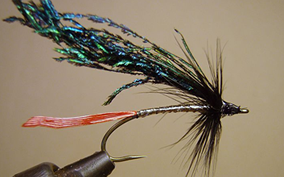
There are many ways to present your streamer, from pounding the banks, to slow and deep strips, long strips, short strips, strip-strip-pause, mend & twitch, dead-drift and swing. With the equipment and rigging style I presented above you can use several techniques to present your streamer to the fish. A little common sense goes a long way when deciding which method will work best the day you are on the river. Here are a few examples: I tend to fish slower and deeper during the spring, winter and late fall or when a significant temperature change has occurred. At this time I typically incorporate longer and slower strips, many times in the deepest and slowest part of the run. When water temps are lower and the trout's metabolism is low, being methodical in your approach is key, hit the trout on the nose. When fishing the banks, I like to key in on structure, seams and drop offs within five feet of the bank. I typically do the best pounding the banks when water temperatures are ideal for trout--in the 50's or so. Your strips are typically fast and erratic and your arm should be thoroughly worn out at the end of the day. This fishing is not for everyone, but can certainly be exciting. When fishing banks, as an angler I am trying to appeal to a trout's opportunistic feeding behavior, where as a predator the trout cannot pass up an easy prey. This is when we typically get the most explosive takes and what I call kill shots. There isn't any chase, just hit your spot with the fly, line goes tight and fish on. If you are getting several chases but no kill shot, then first change the pace of your strip and if that does not work, change your fly. When a river rises and clarity diminishes, the fish will move to the banks. Prime streamer fishing on the banks often occurs when a river is dropping and just clearing. As visibility improves, it is time to pound the banks hard. This trend is very evident on a river such as the Colorado. Another technique I like to use is a dead drift and/or mend and twitch approach. This approach is fished slower and works well in pocket water, around mid-river boulders and fishing runs out of a boat. For example, when you come upon a mid- river boulder you will have deeper holding water in front of, on the sides, and, most of all, behind the boulder as well as in the accompanying downstream seam. Fish in all of these and also try tandem streamer rigs also. But the most ideal conditions will be (unwilling to elevate to a streamer just below the surface), in a short deep hole. Your ability to manipulate your line through mending will allow you to get your fly deep in the hole and most importantly keep it there. Once it's in the strike zone, you can impart action to your fly, in association with the plunging action of the current, through short twitches. Keep your streamer tight to the river bottom (hence the shape of their body) and keeping your fly sliding across the rocks, using a dead drift technique, will increase your catch rate.
--
I am a self-taught fly fisherman who grew up under the bright lights of the big city, Chicago. Now living in Colorado the last twenty plus years fly fishing has been more to me than just a weekend hobby. The sport has become the staple that most my life revolves around, now that I'm retired
Source: http://www.articletrader.com

